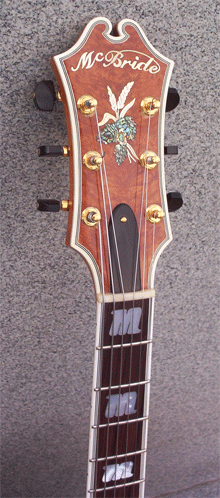
Handmade Archtops by Kenny McBride
Jazz Box
As I gravitated toward jazz, not just in terms of the music I listened to but in terms of the sort of music I wanted to play, a solid body electric just didn't cut it. Yes Ed Bickert, Lorne Lofsky, Mike Stern, and others have played great jazz music on solid-body electrics. And Sco's disciples, such as Steve Cardénas have tended to favor Gibson's ES-335 and its imitators.
Sometimes these preferences relate to ergonomics, people with small frames can find it difficult to reach around a 'fat' guitar along the lines of an ES-175, L5, or Super 400.
For the rest of us, the 'jazz box' becomes, at some point, a holy grail. My own search for such lead to the trade-in of a Gibson RD-Artist, coupled with what I had in the way of a life savings for a Yamaha AE1200S.

This guitar, which I bought in 1987 served me well along with a Polytone Mini-Brute IV. For that matter, I still have both, and have no plans to part with the rig. The Yamaha, which is commonly referred to as an L5 copy, could also be described as a 175 with a rounded cutaway. It has a carved, solid spruce top, with a laminate birch/beech back and sides, maple neck with ebony fingerboard and bridge. It came with both the ebony bridge and a tune-o-matic, but I prefer the warmer sound I get with the ebony. And a tune-o-matic really only serves to give the player the illusion that intonation is anything but a compromise. Ask a piano tuner about that sometime.
My playing career was cut short by an improperly diagnosed repetitive motion disorder. I'd enrolled in the University of North Texas, where I had plans to spend (mainly borrow) $10,000 a year to earn a jazz studies degree. Never mind that the degree would be unlikely to earn me $10,000 a year...
In 1988, if you went to the doctor with a repetitive motion injury, it was tendonitis. End of story. So I was prescribed anti-inflammatories, rest, heating pads, cold packs, physical therapy, all the stuff that was supposed to make tendonitis go away. To no avail, as I found out a decade later, when a neurologist scratched her head and conferred with her own guru and sent me a medical journal article about thoracic outlet syndrome. Not only did the symptoms fit, but with some adjustments to my playing technique I was able to play all I wanted.
Meanwhile, the career as a jazz guitarist was out, but the love of playing wasn't. And I'd started thinking in terms of possibly getting a more acoustically responsive instrument, something unique and hand-made.

Sticker Shock
I started looking about for luthiers who made hand-carved archtops. I could remember seeing heroes such as Ron Escheté in 'Guitar Player' magazine playing guitars by Benedetto, Tom Ribbecke, and Dale Unger.
What I was finding was that on the cheap side, I was looking at $10,000 and a two-year wait. If money was no object, I could wait just as long and spend $50,000 and more.
Compared to prices for, say, a handmade acoustic bass, this is all very reasonable. But not being made out of money, this was going to have to go along side a custom chopper on the list of things I'd like but won't be able to afford in the foreseeable future.
Famous Luthier
I did have enough dough to buy Bob Benedetto's book on the subject of making archtops. I was determined to make this a DIY project, figuring I could buy inexpensive lumbar to practice on and accumulate tools gradually.
Around the same time, I'd gotten into beekeeping as an aspect of my homebrewing hobby. Making my own beer had led to making cider and mead, and making mead (a wine made from honey), led to beekeeping. Hobbies have a way of growing that way with me.
Building a beehive from precut lumber turned out to push my carpentry skills to the limit. Bee's aren't too particular about their housing, but in the process of nailing, gluing, and badly painting those supers, the idea that repeatedly saying, 'I'm going to be a famous luthier someday' was not going to do anything except make my wife start looking in the yellow pages for divorce attorneys. The mantra was initially meant to be a self-fulfilling prophecy, but it ended up mocking me.
Sometimes your best just isn't good enough.
Meanwhile in Houston
I first learned of my Uncle Kenny's luthiership when my Grandma died. When he came up for the funeral, he had a banjo with him he'd built for himself. He builds and repairs fine furniture by trade, and this was something he'd decided to try as a hobby about 30 years ago.
I guess the bit about hobbies taking on a life of their own is genetic, because once he'd built the banjo, he went on to build flat-top steel string and classical guitars, a hammer dulcimer, slide dulcimer, and a violin.
He also took to doing repair work, such as restoring a violin that had belonged to my Great Grandfather, which had been stepped on by a horse.
Fortuitously, he had also taken an interest in archtop guitars, and had the skills and aptitudes to make more than daydreams out of Benedetto's book and videos. In 2002, my dream came true.
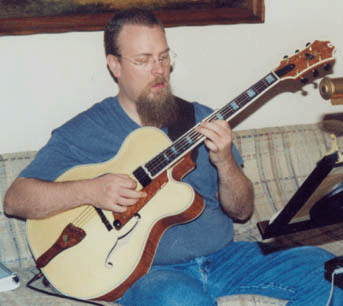
What's the Difference?
Briefly, it's the difference between shooting a bullet and throwing one.
The years when I didn't have a basis for comparison, my Yamaha seemed, to my ears, to have a mighty fine sound unplugged.
One of the big differences between a Lilith (my guitar), or any hand-carved archtop, and a factory made plywood instrument is a quality Lilith is alive. I don't mean that in a New Age sense, though I suppose that applies depending on your temperament. If I hold the guitar my Uncle built (following Benedetto's Cremona design), by it's neck and speak, my voice reverberates through the body. This might not seem remarkable to owners of Taylor, Martin or Olsen flat-tops, but for 'acoustic-electrics' it's amazing.
The dynamic response, richness of tone, and sheer volume of the unplugged instrument dwarfs any factory archtop I've ever encountered. The playability of the neck is comparable to the finest manufactured instruments I've ever come across, but that's where similarity leaves off.
The Benedetto pickup his a hot one. I don't know who they contract with to make them, but the signal is so strong and rich that it seems surprising the magnet doesn't suck the strings down to the frets. It has a stereo out, so if I want to add a microphone over an f-hole at a later time, I can run that into the jack in the tailblock and get a mix of pickup and mic. The one problem with the Benedetto pickup was the plastic volume knob it came with was too tall for the case Kenny found to fit the axe. When you'd go to close the lid of the case, it wanted to press down on the knob, which is on the finger-rest.
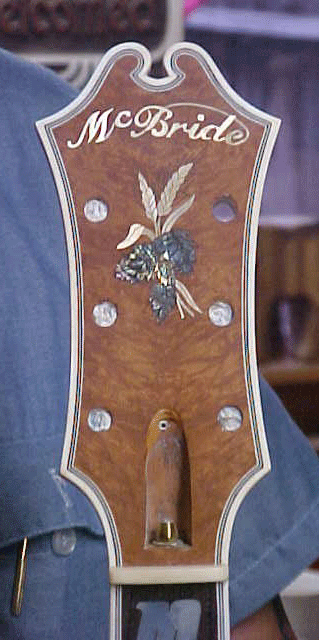
Some things you might not know if you've never played an instrument like this: the pickup floats over the body. For that matter,the fingerboard extension beyond the head-block in the body floats over the top. This is to allow the top plate to vibrate freely. The finger rest attaches to the side of the fingerboard by a couple of screws and hovers over the guitar's top. Pressing down hard on this is not something you want to do.
No problem for Uncle Kenny, who promptly found a block of ebony and fashioned a lower profile volume know on his lathe. So I can honestly say that the volume knob on my guitar has more hand-craftsmanship than anything off a factory line.
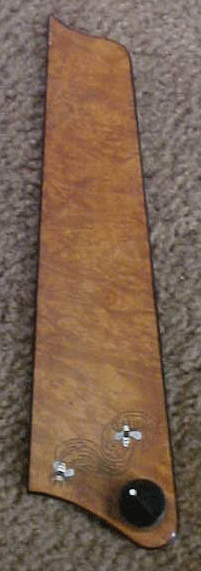
That's a Beautiful Guitar
I used to get that comment about my Yamaha, but not with the tone of awe Lilith inspires.
Obviously, beyond the acoustic properties of the instrument, part of a custom guitar is that yours isn't just like anyone else's. Even though he followed the Cremona templates building my guitar, I'm sure I could sit down with any Cremona owner and we'd find differences and distinctions.
Cosmetically, for starters, Benedetto shows you how to spray lacquer a finish. This has some advantages, especially if you aim to do a sunburst, or really any tinted finish. Spruce doesn't take stain well, so to give the instrument an appearance of age, the sprayer will tend to use traces of amber in their clear lacquer. If you're brushing the lacquer, the chances for success with this approach are slim. And a sunburst, from what I know, really can't be done without going the spray route.
Another difference comes in with the inlay work. One of the nice things about being a graphic artist and having a luthier as skilled as my Uncle Kenny is with inlay work, I got to design the inlays for my instrument. When I sent off my ideas, I had my 'a-list' and a couple of contingencies because I really thought my a-list graphics were probably beyond even master inlay artist.
My phone rang and Kenny said, "I think I like option number one if that's okay with you."
Even the General Manager of a professional sports team doesn't get all his first round draft picks.
Material Differences
Another thing that lends to the variety in handmade instruments is you're dealing with organic materials. No two slabs of spruce are the same, and the tap-tuning process is a matter of the luthier's judgement. Likewise with the maple back and sides. Probably the biggest difference in materials between Lilith and her contemporaries is the Brazilian rosewood fingerboard. Kenny had some left from before the misguided import ban.
As you can see from the pictures, he put gorgeous burl veneer all over the place. The tailpiece and finger rest are made of ebony with the burl veneer beveled to show the black around the edges. The headstock has a veneer of ebony beneath the burl to create a similar effect.
Kenny added his own touches to the inlay work as well. The 'M' block inlays on the fingerboard where his idea.
Can I Buy One?
Kenny isn't big on self-promotion. He's been doing this for around 30 years and has turned down even modest attempts at publicity, such as human interest producers for local TV news programs. He's not averse to a commission for an instrument, but his main interest is in the craft itself.
And he's right to avoid direct promotion. I've advertised on his behalf and generated calls from people who either can't afford to consider the proposition or who are looking for something else entirely in a guitar.
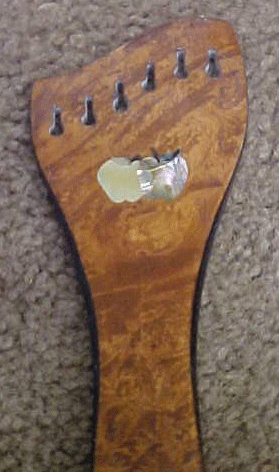
How Much?
As of this coding, I can broker a Kenny McBride archtop to you for $5,500. This price is subject to change, e-mail me and let me know what sort of features you'd want included in your arcthop and I can get a more precise price point.
Serious inquiries please. It doesn't seem like something I should have to explain, but I've had to quit listing phone numbers in advertisements. Yes, it's a lot of scratch, especially if, like me, you play solely for your own pleasure. And it's not an instrument for everyone, the whole idea is that it's an instrument just for you.
Based on the $5,500 price, a $1,500 deposit is required up front, with the balance due on delivery. Basically the deposit takes the edge off if you disappear or lose or your job or otherwise leave us with a custom guitar built to your specifications. If you've got a lot of highly personal inlay work in mind, the deposit might need to be adjusted upward, but that's all stuff that would be worked out ahead of Kenny ordering materials and commencing work.
For your protection, you have a right of first refusal on completion. I guarantee you from personal experience that when you get the finished instrument in your hands, there is a better chance that Elvis is still alive than that you'll want to give it back and get your deposit money.
While a comparison between a handmade guitar and a factory product is an apples-to-onions comparison, it's a matter of what you prefer. You can easily spend as much or more on a new Gibson, for instance. So if a handmade, one of a kind instrument is what you're after, $5,500 may not be cheap, but it is money well spent.

Production time varies, depending on what other instruments Kenny may have under way. This will be addressed when you contact me. It could run as little as six months, which is a lot less waiting than you'll find with some of the luthiers who've been more aggressive about promoting themselves.
What About Other Instruments?
As I said, Kenny has made flat-top guitars, both steel string and classical, in addition to other instruments. If you fancy a flat-top, banjo, violin, etc., contact me and I'll find out what sort of price and turnaround time you'd be looking at. I can tell you up front that if Kenny has any doubts that he has the capability to make it, he won't take the commission. For that matter, if you're wanting an acoustically dead assembly line instrument, he has no interest in being a miniature guitar factory.
One last thing:
The photos on this web site really don't do Kenny's guitars justice. If you live within driving distance of someone who has one, I'll try to hook you up so you can play the real thing and see for yourself.
With some luck, next time the great photographver Julie Denesha is in my area, I can Shanhai her into photographing Lilith. Kind of like with a fine handmade instrument, you just don't realize how much difference a skilled artist makes until you find out your best just isn't good enough.
Maybe by then I'll also have some more web design skill and can put together a site worthy of the best kept secret in the world of luthiers.
